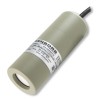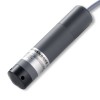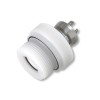Chemical resistant submersible level sensors with a PVC housing and ceramic diaphragm for measuring the hydrostatic level of harsh chemicals.
These sensors have no exposed metal components which would otherwise corrode when exposed to corrosive chemicals. Different cable coatings and seal materials can be chosen to adapt compatibility with specific chemicals, concentration and temperature.
Products
 LMK809 Plastic Submersible Low Level Transmitter - IP68 low range pressure transmitter for measuring the level of highly contaminated and agressive liquid media with a body made from PP-HT or PVDF.
LMK809 Plastic Submersible Low Level Transmitter - IP68 low range pressure transmitter for measuring the level of highly contaminated and agressive liquid media with a body made from PP-HT or PVDF. LMK807 Plastic Submersible Level Transmitter - IP68 mid range pressure transmitter for measuring the level of highly contaminated and aggressive liquid media with a body made from PP-HT.
LMK807 Plastic Submersible Level Transmitter - IP68 mid range pressure transmitter for measuring the level of highly contaminated and aggressive liquid media with a body made from PP-HT.
Applications
 Contaminated groundwater submersible plastic body 5 psi pressure transducer & display - This submersible pressure transducer and display can be used by landfill site pump techs to read leachate water level above the transducer at the well head.
Contaminated groundwater submersible plastic body 5 psi pressure transducer & display - This submersible pressure transducer and display can be used by landfill site pump techs to read leachate water level above the transducer at the well head. 2m range 0.6% conc. chlorine liquid level sensor - Corrosion resistant liquid level sensor to measure up to 2m chlorine solution 0.6% conc.
2m range 0.6% conc. chlorine liquid level sensor - Corrosion resistant liquid level sensor to measure up to 2m chlorine solution 0.6% conc.
 Hot leachate level transmitter for 20m deep well monitoring on landfill sites
Hot leachate level transmitter for 20m deep well monitoring on landfill sites 120cm range 4-20mA submersible chemical tank level sensor for farm water line mineral injection
120cm range 4-20mA submersible chemical tank level sensor for farm water line mineral injection 10m high chemical tank 4-20mA output submersible PVC and ceramic protected liquid level sensor
10m high chemical tank 4-20mA output submersible PVC and ceramic protected liquid level sensor 250cm range 0-10Vdc output plastic submersible chemical tank level sensor
250cm range 0-10Vdc output plastic submersible chemical tank level sensor
- Hydrochloric acid storage tank 1mH2Og hydro-static pressure transmitter
- Sulfuric acid 12-15% conc. drop-in level probe for 10m high tank
- Swimming pool submersible pressure transmitter with 300 mbar range
- Hi-temp level & temperature sensor for 50% NaOH solution
- Plastic seawater depth probe with 20ft range & 4-20mA out
- External corrosive chemical liquid level sensor for installing in a surrounding water bath
Related Product and Application Guides
 Flush Diaphragm
Flush Diaphragm Hydrostatic Pressure
Hydrostatic Pressure Submersible
Submersible Hydrostatic Liquid Level Sensors
Hydrostatic Liquid Level Sensors Liquid Level Sensors
Liquid Level Sensors
